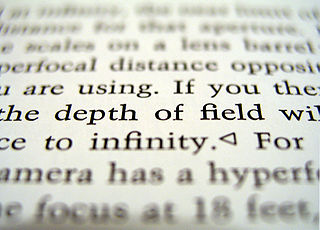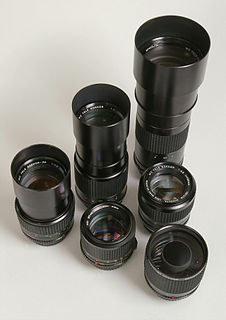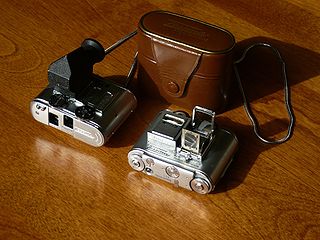
Depth of field is the distance between the nearest and the furthest objects that are in acceptably sharp focus in an image. The depth of field is determined by focal length, distance to subject, the acceptable circle of confusion size, and aperture. A particular depth of field may be chosen for technical or artistic purposes. Some post-processing methods, such as focus stacking allow extended depth of field that would be impossible with traditional techniques.

A single-lens reflex camera (SLR) is a camera that typically uses a mirror and prism system that permits the photographer to view through the lens and see exactly what will be captured. With twin lens reflex and rangefinder cameras, the viewed image could be significantly different from the final image. When the shutter button is pressed on most SLRs, the mirror flips out of the light path, allowing light to pass through to the light receptor and the image to be captured.

A camera is an optical instrument to capture still images or to record moving images, which are stored in a physical medium such as in a digital system or on photographic film. A camera consists of a lens which focuses light from the scene, and a camera body which holds the image capture mechanism.

A twin-lens reflex camera (TLR) is a type of camera with two objective lenses of the same focal length. One of the lenses is the photographic objective or "taking lens", while the other is used for the viewfinder system, which is usually viewed from above at waist level.

A press camera is a medium or large format view camera that was predominantly used by press photographers in the early to mid-20th century. It was largely replaced for press photography by 35mm film cameras in the 1960s, and subsequently, by digital cameras. The quintessential press camera was the Speed Graphic. Press cameras are still used as portable and rugged view cameras.

135 is photographic film in a film format used for still photography. It is a cartridge film with a film gauge of 35 mm (1.4 in), typically used for hand-held photography in 35 mm film cameras. Its engineering standard for the film is controlled by ISO 1007.

In photography, angle of view (AOV) describes the angular extent of a given scene that is imaged by a camera. It is used interchangeably with the more general term field of view.

In photography and cinematography, a wide-angle lens refers to a lens whose focal length is substantially smaller than the focal length of a normal lens for a given film plane. This type of lens allows more of the scene to be included in the photograph, which is useful in architectural, interior and landscape photography where the photographer may not be able to move farther from the scene to photograph it.

In photography and cinematography, a telephoto lens is a specific type of a long-focus lens in which the physical length of the lens is shorter than the focal length. This is achieved by incorporating a special lens group known as a telephoto group that extends the light path to create a long-focus lens in a much shorter overall design. The angle of view and other effects of long-focus lenses are the same for telephoto lenses of the same specified focal length. Long-focal-length lenses are often informally referred to as telephoto lenses although this is technically incorrect: a telephoto lens specifically incorporates the telephoto group.

Subminiature photography is photographic technologies and techniques working with film material smaller in size than 35mm film, such as 16mm, 9.5mm, 17mm, or 17.5mm films. It is distinct from photomicrography, photographing microscopic subjects with a camera which is not particularly small.

Macro photography, is extreme close-up photography, usually of very small subjects and living organisms like insects, in which the size of the subject in the photograph is greater than life size . By the original definition, a macro photograph is one in which the size of the subject on the negative or image sensor is life size or greater. However, in some uses it refers to a finished photograph of a subject at greater than life size.

In photography, a viewfinder is what the photographer looks through to compose, and, in many cases, to focus the picture. Most viewfinders are separate, and suffer parallax, while the single-lens reflex camera lets the viewfinder use the main optical system. Viewfinders are used in many cameras of different types: still and movie, film, analog and digital. A zoom camera usually zooms its finder in sync with its lens, one exception being rangefinder cameras.

The history of the single-lens reflex camera (SLR) begins with the use of a reflex mirror in a camera obscura described in 1676, but it took a long time for the design to succeed for photographic cameras: the first patent was granted in 1861, and the first cameras were produced in 1884 but while elegantly simple in concept, they were very complex in practice. One by one these complexities were overcome as optical and mechanical technology advanced, and in the 1960s the SLR camera became the preferred design for many high-end camera formats.

The Tessina is a high-quality 35 mm camera patented by Austrian chemical engineer Dr. Rudolph Steineck in Lugano Switzerland, manufactured by Siegrist in Grenchen Switzerland. It was introduced in 1957 and distributed by Steineck's company Concava S.A and remained in production up to 1996. The Tessina takes 14x21 mm pictures on standard 35 mm film, making it one of the few subminiature cameras to use the format. It is a very small (2.5x2x1 inch) twin lens reflex, with two 25 mm f/2.8 Tessinon lenses, one for taking the picture, the other for viewing on a tiny ground-glass focusing screen on top of the camera. A 45° mirror is employed to bend incoming light onto the film, which lies along the bottom of the camera rather than the back to save space. Apertures are continuously variable down to f/22, and shutter speeds range from 1/2 to 1/500, and B. The Tessina 35, Tessina L can focus down to 9 inches, Tessina Automatic 35mm to 12 inches. The film is advanced via a clockwork master spring built into the takeup spool, with a pullout winder like the crown on a wristwatch. Each winding can last up to 8 exposures.
The following outline is provided as an overview of and topical guide to photography:
In photography, a long-focus lens is a camera lens which has a focal length that is longer than the diagonal measure of the film or sensor that receives its image. It is used to make distant objects appear magnified with magnification increasing as longer focal length lenses are used. A long-focus lens is one of three basic photographic lens types classified by relative focal length, the other two being a normal lens and a wide-angle lens. As with other types of camera lenses, the focal length is usually expressed in a millimeter value written on the lens, for example: a 500 mm lens. The most common type of long-focus lens is the telephoto lens, which incorporate a special lens group known as a telephoto group to make the physical length of the lens shorter than the focal length.

The 35 mm format, or simply 35 mm, is the common name for the 36×24 mm film format or image sensor format used in photography. It has an aspect ratio of 3:2, and a diagonal measurement of approximately 43 mm. It has been employed in countless photographic applications including single-lens reflex (SLR) cameras, rangefinder cameras, mirrorless interchangeable-lens digital cameras, digital SLRs, point-and-shoot film cameras, and disposable film cameras.

The Narciss is an all-metal 16 mm subminiature single lens reflex camera made by Russian optic firm Krasnogorsky Mekhanichesky Zavod (KMZ) Narciss between 1961 and 1965. It is the first subminiature SLR. It took 25 14×21 mm frames using unperforated specially spooled 16 mm film in a Narciss cassette. Compact design with interchangeable lenses and interchangeable pentaprism finders. The Narciss camera was initially designed for medical use, it included a Narciss with ordinary pentaprism finder and a second magnifier pentaprism finder for medical use; there was also a microscope adapter

Meopta Mikroma is an all metal 16mm subminiature camera made by Meopta in Czechoslovakia, after World War II.

Gemflex is a subminiature twin lens reflex camera made by Showa Optica Works (昭和光学精機) in occupied Japan in the 1950s.
























